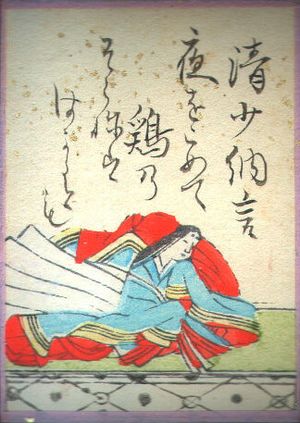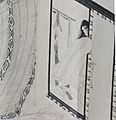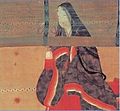Sei Shōnagon facts for kids
Quick facts for kids
Sei Shōnagon
|
|
|---|---|

Sei Shōnagon, illustration from an issue of Hyakunin Isshu (Edo period)
|
|
| Native name |
清少納言
|
| Born | Kiyohara Nagiko (清原 諾子) c. 966 |
| Died | 1017 or 1025 |
| Occupation | Lady-in-waiting to Empress Teishi |
| Nationality | Japanese |
| Period | Heian period |
| Notable works | The Pillow Book |
| Spouse |
|
| Children |
|
| Parents | Kiyohara no Motosuke (father) |
| Relatives | Kiyohara no Fukayabu (grandfather) |
Sei Shōnagon (清少納言) was a famous Japanese author and poet. She was a lady-in-waiting who served Empress Teishi around the year 1000. This was during the middle of Japan's Heian period. Sei Shōnagon is best known for writing a book called The Pillow Book.
Contents
Who Was Sei Shōnagon?
Sei Shōnagon's real name is not fully known. In her time, it was common for court ladies to have nicknames. These names often came from a family member's job.
What Does Her Name Mean?
The name "Sei" comes from her father's family name, "Kiyohara". The "Sei" part is a different way to say "Kiyo". "Shōnagon" refers to a government job, like a "lesser councilor of state". It is not clear how she was connected to this job. Some scholars think her real name might have been Kiyohara no Nagiko.
Sei Shōnagon's Early Life
We don't know much about Sei Shōnagon's early life. Most of what we know comes from her own writings.
Her Family Background
Sei Shōnagon was the daughter of Kiyohara no Motosuke. He was a scholar and a well-known poet. Her grandfather, Kiyohara no Fukayabu, was also a poet. Her family was part of the middle class of courtiers. They sometimes had money problems.
Her Marriages and Children
When she was 16, Sei Shōnagon married Tachibana no Norimitsu. He was a government official. They had a son named Norinaga. In 993, when she was 27, she started working for Empress Teishi. Empress Teishi was the wife of Emperor Ichijō. Sei Shōnagon may have been divorced by then.
After her time at court, she might have married Fujiwara no Muneyo. He was a governor. They may have had a daughter named Koma no Myobu. Some people believe she became a Buddhist nun later in life.
Sei Shōnagon's Rivalry with Murasaki Shikibu
Sei Shōnagon was known for her rivalry with another famous writer, Murasaki Shikibu. Murasaki Shikibu wrote The Tale of Genji. She also served Empress Shoshi, who was Emperor Ichijō's second wife.
Murasaki Shikibu wrote about Sei Shōnagon in her diary. She was a bit critical of Shōnagon. However, she still admitted that Shōnagon was a very talented writer.
Sei Shōnagon's Famous Writings
Sei Shōnagon became very popular because of her book, The Pillow Book.
What is The Pillow Book?
The Pillow Book is a collection of many different things. It has lists, stories, poems, and her thoughts. She wrote it during her years serving in the court. This type of writing is called zuihitsu.
Her book describes daily life and customs of her time. It also shares details about the Imperial Court in Kyoto. She wrote from her own unique point of view.
The Pillow Book was first shared as handwritten copies. It was not printed until the 1600s. There are different versions of the book today. This is because people who copied it might have changed the order of entries. They might have also added or removed parts.
Modern scholars know of four main versions. The most complete ones are called the Sankanbon and Nōinbon texts. The Sankanbon text has 297 main sections. It also has 29 extra sections that might have been added later.
Life at Court in The Pillow Book
In her book, Sei Shōnagon writes about Empress Teishi. She also shares her feelings when Empress Teishi's father died. Another empress, Shōshi, joined the court. This meant there were two empresses.
Sei Shōnagon wrote about court events in a lighthearted way. She often left out sad or difficult parts, like Empress Teishi's death. This was because it was considered stylish to write in a cheerful way back then. Her writing is seen as clever and gives a detailed look at Empress Teishi's elegant court.
Sei Shōnagon's Skills
People at court thought Sei Shōnagon had an amazing memory. Her writings include many memories of court events. She remembered small details, like what people wore. She wrote these details down years after they happened.
She was also very good at remembering and quoting classic poems. This was a very important skill in the court.
Advice and Observations in Her Book
The Pillow Book also gives advice on talking, preaching, and writing letters.
- On Conversation: Sei Shōnagon believed in using clear language and proper manners when talking. But she also showed examples of fun and witty conversations.
- On Preaching: She thought priests should be handsome and good at speaking. They should also have great memories. Their audience should pay attention and be polite. She felt that a good-looking priest helped people focus on the sermon.
- On Letter Writing: She gave detailed advice on how to write letters. This included what paper to use and how to write neatly. She also talked about gifts to send with letters. She especially focused on "morning-after letters." These were poems sent by men to ladies after a visit. The lady was expected to reply.
One of her poems is in a famous collection called Ogura Hyakunin Isshu.
Sei Shōnagon's Later Years
We don't have many details about Sei Shōnagon's life after the year 1000. This was when Empress Teishi died.
One story says she lived her last years as a poor Buddhist nun. Another story says she married Fujiwara no Muneyo. This happened after she left court. They had a daughter named Koma no Myobu. The Pillow Book is believed to have been finished between 1001 and 1010. This was when Sei Shōnagon was no longer at court.
Images for kids
-
Sei Shōnagon, drawing by Kikuchi Yosai (1788–1878)
See also
 In Spanish: Sei Shōnagon para niños
In Spanish: Sei Shōnagon para niños




